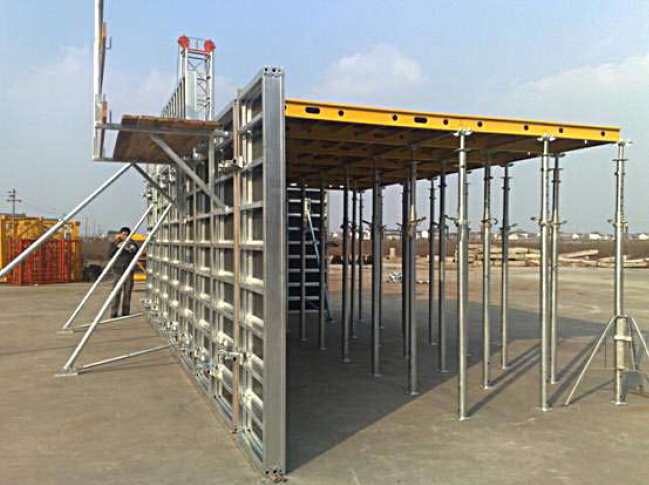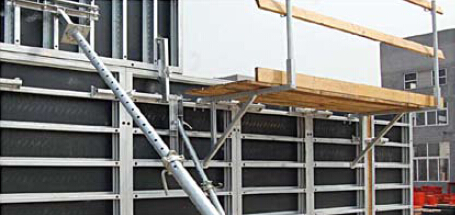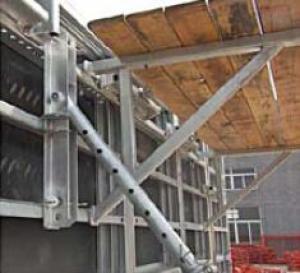Steel-Frame working platformfor Formwork and Scaffolding systems
- Loading Port:
- Tianjin
- Payment Terms:
- TT OR LC
- Min Order Qty:
- 50 m²
- Supply Capability:
- 1000 m²/month
OKorder Service Pledge
OKorder Financial Service
You Might Also Like
Steel-frame Formwork SF-140
Characteristics:
◆ Few parts for fast forming.
◆ Max. Concrete pressure: 80KN/m2.
◆ Hot-dip galvanized steel frame.
◆ The thickness of plywood is 18mm & the panel is 14cm.
◆ Compatibility with Hunnebeck Manto system due to similar edge profile.
System Details & Application:
◆ Neat joint and fast assembling with aligning panel clamp.
◆ Flexible panel arrangement and height extension.
◆ The selection of panels.
◆ Kinds of panel connectors.
◆ Corner clamp application.
◆ Length adjustment application.
◆ Height adjustment & aligning strut.
◆ Walkway bracket & platform.


- Q:What are the different types of formwork bracing used in steel formwork?
- There are several types of formwork bracing used in steel formwork, including diagonal braces, horizontal braces, vertical braces, and cross braces. These bracing elements are essential for providing stability and support to the formwork system, ensuring the safe construction of concrete structures.
- Q:What are the different surface finishes available for steel formwork?
- There are several different surface finishes available for steel formwork, depending on the specific requirements and preferences of the project. 1. Smooth finish: This is the most common surface finish for steel formwork. It involves grinding or sanding the surface to create a smooth and even appearance. Smooth finishes are ideal for projects that require a high level of precision and aesthetic appeal. 2. Textured finish: Some projects may require a textured surface finish for better bonding with concrete. This can be achieved through various methods, such as shot blasting or using textured form liners. Textured finishes provide additional grip and can enhance the bond between the formwork and concrete. 3. Brushed finish: Brushed finishes involve using wire brushes or abrasive pads to create a slightly rougher surface. This finish is often chosen for applications where slip resistance is important, such as on ramps or walkways. 4. Etched finish: Etching is a chemical process that creates a matte or patterned finish on steel formwork. This finish is commonly used for decorative purposes, as it can create unique designs or patterns on the surface. 5. Galvanized finish: Galvanizing is a coating process that involves applying a layer of zinc to the steel formwork. This finish provides excellent corrosion resistance, making it suitable for projects in harsh or corrosive environments, such as marine or industrial applications. 6. Powder-coated finish: Powder coating is a durable and decorative finish that involves applying a dry powder to the steel formwork and then curing it with heat. This finish is available in a wide range of colors and provides excellent resistance to impact, chemicals, and UV radiation. It's important to consider the specific requirements of the project, such as durability, aesthetics, and environmental conditions, when selecting the appropriate surface finish for steel formwork. Consulting with a structural engineer or formwork supplier can help determine the best finish for the intended application.
- Q:How much weight can steel formwork support?
- The weight that steel formwork can support depends on various factors such as the size and thickness of the steel, the design of the formwork, and the supporting structure. Generally, steel formwork is capable of supporting heavy loads ranging from a few hundred kilograms to several tonnes.
- Q:Can steel formwork be used for both single-story and multi-story structures?
- Yes, steel formwork can be used for both single-story and multi-story structures. Steel formwork is highly versatile and can be easily adjusted and customized to meet the specific requirements of different types of structures. It provides excellent strength and durability, allowing it to handle the load-bearing requirements of multi-story structures with ease. Additionally, steel formwork offers a smooth and high-quality finish, which is essential for both single-story and multi-story structures. It also allows for easy assembly and disassembly, making it a cost-effective and efficient option for construction projects of varying scales. Overall, steel formwork is a suitable choice for both single-story and multi-story structures due to its versatility, strength, durability, and ease of use.
- Q:What are the different sizes and dimensions of steel formwork panels?
- The sizes and dimensions of steel formwork panels can vary depending on the specific project requirements. However, common sizes range from around 600mm x 1200mm to 2400mm x 3000mm, with thicknesses typically ranging from 12mm to 18mm. These panels are designed to be sturdy and versatile, allowing for efficient construction processes.
- Q:What are the different transportation and storage requirements for steel formwork?
- Steel formwork, being a heavy and durable material, requires specific transportation and storage requirements. For transportation, it is crucial to have suitable vehicles with sufficient carrying capacity to accommodate the weight of the steel formwork. Additionally, proper securing and fastening mechanisms should be employed to prevent any movement or damage during transportation. Regarding storage, steel formwork should be kept in a dry and well-ventilated area to prevent corrosion. It is essential to protect the steel formwork from exposure to moisture, extreme temperatures, and direct sunlight, as these factors can deteriorate its quality. Furthermore, proper stacking methods and supports should be utilized to prevent any deformation and ensure the longevity of the steel formwork.
- Q:Are there any safety considerations when using steel formwork?
- Yes, there are several safety considerations when using steel formwork. Firstly, it is important to ensure that the formwork is properly erected and secured to prevent any potential collapse or accidents. Regular inspections should be conducted to check for any signs of damage or wear that could compromise the structural integrity. Adequate training and supervision of workers is crucial to ensure safe handling and installation of the formwork. Additionally, appropriate personal protective equipment (PPE) such as helmets, gloves, and safety harnesses should be provided and worn by workers at all times.
- Q:What are the common finishes available for steel formwork?
- There are several common finishes available for steel formwork, depending on the specific requirements of the project. Some of the most common finishes include: 1. Smooth finish: This is the most basic and commonly used finish for steel formwork. It provides a smooth surface that is suitable for most applications. 2. Textured finish: A textured finish can be achieved by using special form liners or by applying a textured coating to the steel formwork. This finish can add visual interest and provide a non-slip surface. 3. Galvanized finish: Galvanizing is a process of applying a protective zinc coating to the steel formwork. This finish provides excellent corrosion resistance, making it suitable for projects in harsh environments. 4. Powder-coated finish: Powder coating involves applying a dry powder to the steel formwork and then curing it with heat to form a protective layer. This finish offers durability, resistance to chipping and scratching, and a wide range of color options. 5. Painted finish: Steel formwork can also be painted to achieve the desired aesthetic appearance. Paint provides protection against corrosion and can be customized to match the project's design requirements. It is important to consider the specific project requirements, including the expected lifespan, environmental conditions, and aesthetic preferences, when selecting the appropriate finish for steel formwork. Additionally, it is recommended to consult with a structural engineer or a construction professional to determine the most suitable finish for a particular project.
- Q:How does steel formwork affect the overall energy efficiency of a structure?
- Steel formwork can have a significant impact on the overall energy efficiency of a structure. Firstly, steel formwork is known for its durability and strength, which allows it to be reused multiple times. This reusability reduces the need for new formwork materials, thereby minimizing waste generation and conserving resources. By reducing the amount of waste produced during construction, the overall environmental impact is reduced, leading to improved energy efficiency. Additionally, steel formwork offers excellent thermal properties. It has a high thermal mass, meaning it can absorb and store heat energy effectively. This characteristic helps regulate the temperature inside the structure, reducing the reliance on heating or cooling systems. By stabilizing the internal temperature, the energy consumption for climate control is reduced, resulting in improved energy efficiency and lower operational costs. Furthermore, steel formwork enables the construction of energy-efficient designs. Its versatility allows for complex shapes and configurations, facilitating the integration of energy-saving elements such as insulation, ventilation systems, and renewable energy technologies. These features contribute to the overall energy performance of the structure, enhancing its efficiency and sustainability. Overall, steel formwork positively impacts the energy efficiency of a structure by reducing waste, providing excellent thermal properties, and enabling energy-efficient designs. By utilizing steel formwork, construction projects can achieve higher levels of sustainability and contribute to a greener and more energy-efficient built environment.
- Q:How does steel formwork affect the overall efficiency of the construction process?
- Steel formwork can greatly enhance the overall efficiency of the construction process. Its durability and strength allow for repeated use, reducing the need for constant replacement. Additionally, steel formwork offers better precision and accuracy in shaping concrete structures, resulting in faster and more efficient construction. Its versatility enables the creation of complex designs, saving time and effort. Moreover, steel formwork provides excellent support and stability, ensuring safety during the construction process. Overall, the use of steel formwork leads to increased productivity, reduced labor costs, and timely project completion.
1. Manufacturer Overview |
|
|---|---|
| Location | |
| Year Established | |
| Annual Output Value | |
| Main Markets | |
| Company Certifications | |
2. Manufacturer Certificates |
|
|---|---|
| a) Certification Name | |
| Range | |
| Reference | |
| Validity Period | |
3. Manufacturer Capability |
|
|---|---|
| a)Trade Capacity | |
| Nearest Port | |
| Export Percentage | |
| No.of Employees in Trade Department | |
| Language Spoken: | |
| b)Factory Information | |
| Factory Size: | |
| No. of Production Lines | |
| Contract Manufacturing | |
| Product Price Range | |
Send your message to us
Steel-Frame working platformfor Formwork and Scaffolding systems
- Loading Port:
- Tianjin
- Payment Terms:
- TT OR LC
- Min Order Qty:
- 50 m²
- Supply Capability:
- 1000 m²/month
OKorder Service Pledge
OKorder Financial Service
Similar products
New products
Hot products
Related keywords























